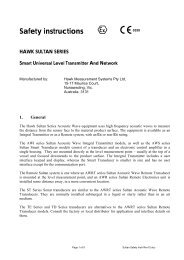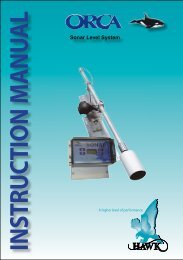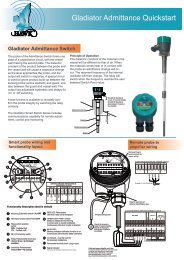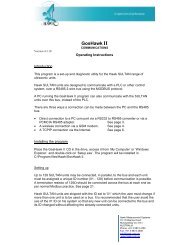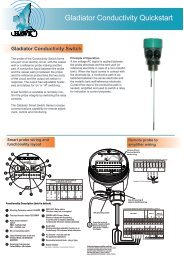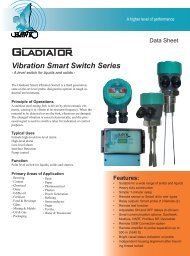Download File - Hawk Measurement Systems!
Download File - Hawk Measurement Systems!
Download File - Hawk Measurement Systems!
Create successful ePaper yourself
Turn your PDF publications into a flip-book with our unique Google optimized e-Paper software.
Microwave Pulse Switch - Presence & Absence DetectionMANUALRev 1.0Principle of OperationREMOTE SYSTEMThe <strong>Hawk</strong> Microwave Pulse Sender-Receiver RemoteSystem is comprised of three electrically isolated units:-the Sender, Receiver and Amplifier. The sender-receiverunits are mounted facing each other. For best performanceit is essential that they be mounted securelyand correctly aligned.The sender emits a burst of microwave energy towardthe receiver, which is designed around a tuned microwavedetector. This burst of energy is transmittedapproximately 200 times each second. While the line ofsight is interrupted by a sufficiency reflective or absorbentmaterial the energy will not reach the receiver, andtherefore the receiver will not detect the transmission.The receiver is designed to switch a relay when it’sdetector changes state. Time delays between detectorchange and relay switching is set via two single turnpotentiometers; there is a potentiometer for the make(signal detected) delay and another for the break (signalinterrupted) delay. In each case the relay will switch onlyafter the detector state has been maintained (since it’schange) for the respective time: any further change ofstate during a time-out period will override the previouschange.The sensitivity of the detector is adjusted by a potentiometer.By this adjustment, compensation can be made forpartially reflective or partially absorbing materials. Similarly,it can be adjusted so that it will change state whenonly a fraction of the beam is blocked. There are twosensitivity adjustment potentiometers, one for a coarseadjustment and the other for a fine adjustment.In the Amplifier unit there are three LED lamps; one indicatesthat power is applied, another indicates that a validsignal is detected, and the other indicates that the relayis energized. In the sender unit the only lamp is the oneindicating that power is applied.INTEGRAL SYSTEMThe <strong>Hawk</strong> Microwave Pulse Sender-Receiver IntegralSystem was created for process control applicationsrequiring highly reliable non-contact absence/presencemonitoring. The flexibility of the system allows for notonly point level indication, but also flow/no flow, proximitysensing, absence/presence and plug chute detection inmany different processes.The Integral system consists of the Microwave PulseSender (MPS) unit and Microwave Pulse Receiver(MPR) unit. Each unit can be powered by 115Vac/240Vac or 24Vdc, mounted by flange or 3”NPT weldmentand is provided in an SM listed NEMA 4X enclosurefor maximum flexibility.The MPS unit has one LED indicator for power and a100mA/250Vac fuse. It also has a TEST push-buttonfor ease of setup and troubleshooting. Inside the MPR,there are three LED indicators for the following: power,signal detect and relay energized indications as well as auser accessible 100mA/250Vac fuse.The MPS unit contains a tuned microwave diode thatemits a continuous stream (approximately200 burstseach second) of microwave energy towards the MPRunit. The MPR contains a tuned microwave detectorwhich will only accept signals from the MPS. When thesender and receiver are mounted in a direct line of sightand correctly aligned, the receiver will detect interruptionsof these bursts. In effect, there is a microwavebeam between the sender and receiver. While the lineof sight is clear, the MPR will detect an uninterruptedstream. When the beam is interrupted by a sufficientlyconductive material, the receiver detector will sense theinterruptions and change states. This change of detectorstates activates the relay, thus giving the basis forabsence/presence indication.Sensitivity of the receiver in the MPR is controlled by twosingle turn potentiometers: one for fine adjustment andthe other for coarse adjustment. The sensitivity adjustmentallows for compensation when monitoring partiallyconductive material. Similarly, it can be adjusted so thatit will change state when only a fraction of the beam isinterrupted.The SPDT relay of the MPR unit can be set to eitherenergize or de-energize when the beam is broken. Thisselection is made via the two-position slide switch nextto the power input terminals.The MPR unit also contains two time delays for controllingand fine tuning its relay operation: the make (signaldetected) and break (signal interrupted) adjustments.Each delay is independently adjustable by a single turnpotentiometer from 100ms to 30 seconds. The relay willswitch only after the detector state (signal/no signal)has been maintained for the time specified by the setpoint on the potentiometer. Any time there is a change inSultanstate,234theSeriestimers are automatically reset.For a more detailed list of specifications, please refer tothe Specifications section of this manual.Microwave Series



